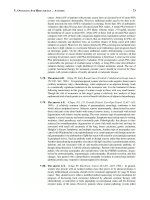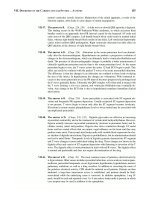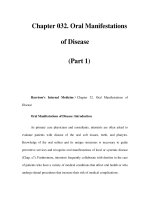Chapter 054. Skin Manifestations of Internal Disease (Part 3) pot
Bạn đang xem bản rút gọn của tài liệu. Xem và tải ngay bản đầy đủ của tài liệu tại đây (13.52 KB, 5 trang )
Chapter 054. Skin Manifestations
of Internal Disease
(Part 3)
Drug-induced erythroderma (exfoliative dermatitis) may begin as an
exanthematous (morbilliform) eruption (Chap. 56) or may arise as diffuse
erythema. A number of drugs can produce an erythroderma, including penicillins,
sulfonamides, carbamazepine, phenytoin, gold, allopurinol, and zalcitabine. Fever
and peripheral eosinophilia often accompany the eruption, and there may also be
facial swelling, hepatitis, and allergic interstitial nephritis; this constellation is
frequently referred to as drug reaction with eosinophilia and systemic symptoms
(DRESS). In addition, reactions to anticonvulsants can lead to a pseudolymphoma
syndrome (with adenopathy and circulating atypical lymphocytes), while reactions
to allopurinol may be accompanied by gastrointestinal bleeding.
The most common malignancy that is associated with erythroderma is
CTCL; in some series, up to 25% of the cases of erythroderma were due to CTCL.
The patient may progress from isolated plaques and tumors, but more commonly
the erythroderma is present throughout the course of the disease (Sézary
syndrome). In the Sézary syndrome, there are circulating atypical T lymphocytes,
pruritus, and lymphadenopathy. In cases of erythroderma where there is no
apparent cause (idiopathic), longitudinal follow-up is mandatory to monitor for the
possible development of CTCL. There have been isolated case reports of
erythroderma secondary to some solid tumors—lung, liver, prostate, thyroid, and
colon—but it is usually in a late stage of the disease.
Alopecia
(Table 54-4) The two major forms of alopecia are scarring and nonscarring.
In scarring alopecia there are associated fibrosis, inflammation, and loss of hair
follicles. A smooth scalp with a decreased number of follicular openings is usually
observed clinically, but in some cases the changes are seen only in biopsy
specimens from the affected areas. In nonscarring alopecia the hair shafts are
gone, but the hair follicles are preserved, explaining the reversible nature of
nonscarring alopecia.
Table 54-4 Causes of Alopecia
I. Nonscarring alopecia
A. Primary cutaneous disorders
1. Telogen effluvium
2. Androgenetic alopecia
3. Alopecia areata
4. Tinea capitis
5. Traumatic alopecia
a
B. Drugs
C. Systemic diseases
1. Lupus erythematosus
2. Secondary syphilis
3. Hypothyroidism
4. Hyperthyroidism
5. Hypopituitarism
6. Deficiencies of protein, iron, biotin, and zinc
II. Scarring alopecia
A. Primary cutaneous disorders
1. Cutaneous lupus (chronic discoid)
2. Lichen planus
3. Folliculitis decalvans
4. Linear scleroderma (morphea)
5. Central centrifugal cicatricial alopecia
B. Systemic diseases
1. Lupus erythematosus
2. Sarcoidosis
3. Cutaneous metastases









